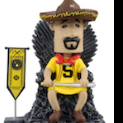
Brewers Video
Pitching is most often treated as a matter of physics, and that’s not untrue. Nor, however, is it the whole truth. It’s also an exercise in geometry. In the batter-pitcher showdown, all the angles matter. Arm angles are important, but so is where a pitcher elects to start his delivery. For Eric Lauer, the latter is especially telling.
Generally speaking, of course, lower arm angles make pitchers more effective against same-handed batters, but less so against opposite-handed ones. (The reverse is true of high arm slots, although to a lesser extent.) That’s mostly because a pitcher can create more horizontal movement from a lower slot, but it’s also about the angle created when a pitcher releases the ball especially far toward one base or the other. An extreme stride pattern can change that, and so can an extreme arm slot, but the easiest, most mechanics-neutral way to do it is to slide to one or the other end of the pitching rubber.
Often, you’ll see a hurler whose stuff moves a lot to their arm side (in on a same-handed batter) set up on the “glove” side of the rubber. For a lefty like Lauer, that’s the third-base end of the rubber. However, Lauer’s stuff mostly moves to his glove side, so when he was with the Padres, he set up roughly in the middle of the rubber. If anything, he tended to be on the first-base side of that center line. That remained true until the summer of 2021, in fact.
Halfway through 2021, Lauer made a significant move. He got over to the third-base edge of the rubber–the opposite of the direction we might expect a lefty whose arsenal features a slider and a cutter to go. He stayed there throughout the second half of that season, during which time he was dominant as the Brewers stormed to the NL Central title.
In the first half of 2022, though, he moved even farther in that direction, and it started to cause predictable problems.
He missed bats at an impressive rate from that spot on the mound, and he didn’t walk many batters. Too much hard contact plagued him, though. He seemed to struggle to calibrate the usage of his new stuff from that angle. Thus, during the second half of 2022, he found his goldilocks zone, back toward the middle of the rubber.
Why doesn’t Lauer pitch from the first-base side of the rubber, given his arsenal and his stuff? Much of the answer lies in the same real estate we explored at the end of yesterday’s piece, with regard to why Lauer throws his fastball high and earns whiffs against righties, but not against lefties: Lauer’s psyche. It’s clear that he’s not comfortable executing the high fastball to lefties. It’s clear that he doesn’t like trying to get his stuff all the way across from the first-base side of the rubber to the third-base side of home. When he does so, he finds too much of the plate. His stuff doesn’t move as sharply. He doesn’t execute.
Lauer gets the most out of his fastball by setting up right where he currently is. His revamped delivery and his placement on the rubber make room for the natural run on his heater. Unfortunately, he doesn’t seem to get much out of his other offerings from the same spot. Nor is being where he is on the rubber going to help him be more consistently effective against lefties. Because his four-seamer is the best pitch in his repertoire, though, he probably does best by staying where he is now.
What adjustments remain to help him be a full-fledged mid-rotation starter in 2023, then? For one thing, he could streamline his pitch mix. Together, Lauer and the Brewers reshaped his slider during the second half of 2022. The new version is more vertical in shape, and it’s a pitch he can use against both righties and lefties. The same goes, in a smaller way, for the cutter. Here's a chart showing his horizontal and vertical movement by month and pitch type last year; the black boxes are around the cutter and slider points for the latter half of the year.

That’s helpful, because he’s been leaning too much on his unimpressive curveball. He should all but junk that pitch, continue to eschew his changeup, and focus on getting the most out of his four-seamer, cutter, and slider. He can dominate without further tinkering with his mechanics or his mound position, and enjoy the better command that comes with not trying to juggle so many related offerings. If he does so, Lauer could be even better in 2023 than over the previous two campaigns.
Think you could write a story like this? Brewer Fanatic wants you to develop your voice, find an audience, and we'll pay you to do it. Just fill out this form.
MORE FROM BREWER FANATIC
— Latest Brewers coverage from our writers
— Recent Brewers discussion in our forums
— Follow Brewer Fanatic via Twitter, Facebook or email
-
 1
1










Recommended Comments
There are no comments to display.
Join the conversation
You can post now and register later. If you have an account, sign in now to post with your account.
Note: Your post will require moderator approval before it will be visible.